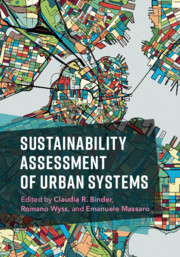Book contents
- Sustainability Assessment of Urban Systems
- Sustainability Assessment of Urban Systems
- Copyright page
- Contents
- Preface
- Acknowledgments
- Contributors
- General Introduction
- Part I Theoretical Background
- 1 Sustainability Assessment: Introduction and Framework
- 2 Systems Science and Sustainability Assessment
- 3 How Values Play into Sustainability Assessments: Challenges and a Possible Way Forward
- 4 The Politics of Participatory Sustainability Assessments: An Analysis of Power
- 5 A Concept for Sustainability Transition Assessment (STA): A Dynamic Systems Perspective Informed by Resilience Thinking
- Part II Integrative Approaches for Sustainability Assessment
- Part III Perspectives on Urban Sustainability
- Part IV Focal Points of Urban Sustainability
- Index
- References
4 - The Politics of Participatory Sustainability Assessments: An Analysis of Power
from Part I - Theoretical Background
Published online by Cambridge University Press: 27 March 2020
- Sustainability Assessment of Urban Systems
- Sustainability Assessment of Urban Systems
- Copyright page
- Contents
- Preface
- Acknowledgments
- Contributors
- General Introduction
- Part I Theoretical Background
- 1 Sustainability Assessment: Introduction and Framework
- 2 Systems Science and Sustainability Assessment
- 3 How Values Play into Sustainability Assessments: Challenges and a Possible Way Forward
- 4 The Politics of Participatory Sustainability Assessments: An Analysis of Power
- 5 A Concept for Sustainability Transition Assessment (STA): A Dynamic Systems Perspective Informed by Resilience Thinking
- Part II Integrative Approaches for Sustainability Assessment
- Part III Perspectives on Urban Sustainability
- Part IV Focal Points of Urban Sustainability
- Index
- References
Summary
The participation of societal actors has been advanced as the gold standard of sustainability assessment processes and is thought essential to dealing with the plurality of normative claims surrounding sustainability and the need to take decisions in a context of trade-offs. However, participation per se does not guarantee these outcomes. In this chapter, we put the spotlight on the politics of participatory sustainability assessments and look at the entanglements of knowledge and power in such processes. First, we introduce different conceptualisations of participation and show that participation is a contested concept that goes beyond methodological questions. Second, to equip ourselves for a discussion of the politics of participatory sustainability assessments, we present an analytical framework for studying diverse facets of power (‘power over’, ‘power to’, and ‘power with’) throughout participatory sustainability assessment processes. By means of a literature analysis, we illustrate how, depending on the design of the process and the socio-political context in which it takes place, different power relations pervade and shape participation processes and their outcomes. The analytical framework presented can support reflexivity in tackling power dynamics in participatory sustainability assessments.
- Type
- Chapter
- Information
- Sustainability Assessment of Urban Systems , pp. 87 - 122Publisher: Cambridge University PressPrint publication year: 2020

